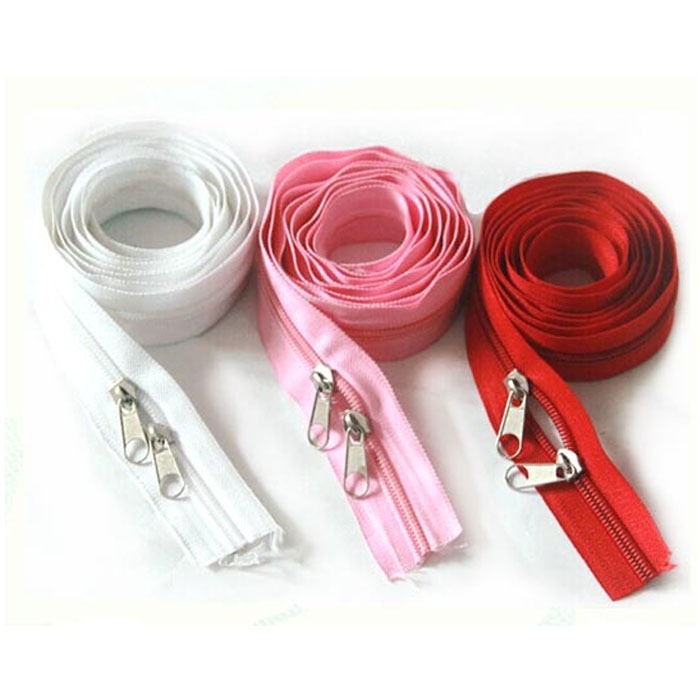Zippers are versatile fastening mechanisms that find extensive use in a wide range of products, from garments to bags and beyond. Understanding the different types of zipper applications is essential when customizing zippers to suit specific needs. In this article, we will delve into the five primary types of zipper applications, exploring their distinct characteristics, uses, and considerations for customization.
1. Garment Zippers
Garment zippers are among the most common and widely recognized types of zippers. They are primarily used in clothing items, including dresses, pants, skirts, jackets, and various other garments. Custom garment zippers are tailored to match the design requirements of the clothing item, while ensuring ease of use and reliable functionality.
Considerations for Customization:
- Length: Select the appropriate zipper length based on the garment's design and closure requirements.
- Color and Finish: Customize the zipper's color and finish to seamlessly integrate with the fabric and overall aesthetic of the garment.
- Slider Design: Choose a slider design that complements the garment's style and allows for smooth opening and closing.
2. Bag Zippers
Bag zippers are specifically designed to provide secure closures for bags, backpacks, purses, and luggage. These zippers are typically more robust and durable to withstand the demands of frequent use and varying loads. Custom bag zippers can be tailored to match the bag's design, size, and functionality, ensuring a reliable closure mechanism.

Considerations for Customization:
- Strength and Durability: Select a zipper size and material that can handle the weight and stress associated with the specific bag's usage.
- Tape Color and Design: Customize the tape color and design to align with the bag's overall aesthetic and branding elements.
- Puller and Slider Customization: Personalize the puller and slider with logos, engravings, or custom shapes to enhance the bag's visual appeal and brand identity.
3. Furniture Zippers
Furniture zippers play a crucial role in upholstery, enabling the easy removal and replacement of cushion covers and fabric panels. These zippers are typically heavy-duty and require smooth operation, as they are subject to repeated use during the lifespan of furniture. Custom furniture zippers should be selected based on durability, ease of installation, and compatibility with the furniture's design.
Considerations for Customization:
- Strength and Durability: Choose heavy-duty zippers that can withstand the weight and stress associated with furniture upholstery.
- Length and Zipper Teeth Size: Determine the appropriate length and zipper teeth size based on the specific furniture application and the fabric thickness.
- Tape Color and Design: Customize the tape color and design to match the upholstery and seamlessly blend with the furniture's overall appearance.
4. Tent Zippers
Tent zippers are designed to provide reliable closures for outdoor tents, canopies, and camping gear. These zippers must be durable, weather-resistant, and easy to operate under various conditions. Custom tent zippers should be selected based on their ability to withstand exposure to the elements and provide a secure closure for the outdoor shelter.
Considerations for Customization:
- Weather Resistance: Opt for zippers made from materials that are resistant to water, UV rays, and temperature fluctuations to ensure long-lasting performance.
- Strength and Durability: Choose zippers that can withstand the tension and stress associated with setting up and taking down tents.
- Slider and Puller Design: Customize the slider and puller for easy gripping and smooth operation, even when wearing gloves or in low light conditions.
5. Automotive Zippers
Automotive zippers are specifically engineered for use in automotive interiors, such as car seats, convertible tops, and upholstery. These zippers must be durable, resistant to wear and tear, and able to handle frequent use. Custom automotive zippers should be selected based on their ability to withstand exposure to sunlight, temperature fluctuations, and the demands of automotive applications.
Considerations for Customization:
- Material and Finish: Choose zippers made from materials that are resistant to fading, UV radiation, and friction to maintain their appearance and functionality over time.
- Strength and Durability: Select zippers that can endure the stress associated with automotive applications and the constant opening and closing of seat covers or convertible tops.
- Slider and Puller Design: Customize the slider and puller for easy gripping and smooth operation, even in confined spaces.
Conclusion
Understanding the five primary types of zipper applications—garment, bag, furniture, tent, and automotive—provides valuable insights for selecting and customizing zippers to meet specific needs. By considering factors such as strength, durability, tape color and design, puller and slider customization, and material selection, custom zippers can seamlessly integrate with various products while ensuring reliable functionality and enhancing their overall aesthetic appeal. Whether it's clothing, bags, furniture, tents, or automotive applications, custom zippers can be tailored to meet diverse design requirements, ensuring a secure and visually appealing closure mechanism.


